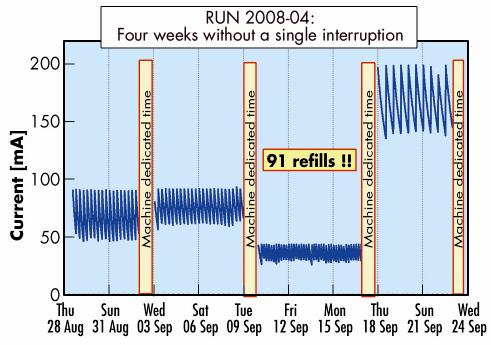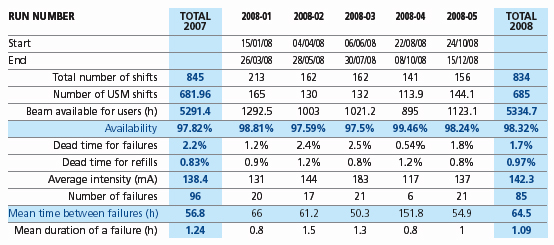- Home
- Users & Science
- Scientific Documentation
- ESRF Highlights
- ESRF Highlights 2008
- Accelerator and X-ray Source
Accelerator and X-ray Source
Introduction
Throughout 2008, the Accelerator and Source Division has continued its efforts to ensure reliable operation as well as preparing for the forthcoming upgrade. A number of developments have been carried out, the most important of these are described hereafter.
Beam parameters of the storage ring
Table 2 presents a summary of the characteristics of the storage ring’s electron beam.
 |
|
Table 2: Principal characteristics of the electron beam. |
Table 3 gives the main optic functions, electron beam sizes and divergences at various source points. For insertion device source points, the beta functions, dispersion, sizes and divergences are calculated in the middle of the straight section.
 |
|
Table 3: Beta functions, dispersion, rms beam size and divergence for the various source points. |
Two representative source points for each type of bending magnet (even or odd number) have been selected, corresponding to observation angles of 3 and 9 mrad from the exit. The bending magnets are such that the magnetic field is 0.4 T and 0.85 T at the tangent point where the radiation is extracted at 3 and 9 mrad angles, respectively. Electron beam profiles are Gaussian and the size and divergence are presented in terms of rms quantities. The associated full width half maximum sizes and divergences are 2.35 times higher. Horizontal electron beam sizes and divergences are given for the uniform filling modes and apply to almost all filling patterns except for the single bunch, for which a slightly larger size and divergence is attained because of the increased energy spread of the electron beam. Vertical electron beam sizes and divergences apply to the uniform, 2 x 1/3 and hybrid filling modes only. To increase the lifetime of the stored beam, the vertical beam sizes and divergences are increased by about 50% in the 16 and 4 bunch filling patterns.
The lifetime, bunch length and energy spread mainly depend on the filling pattern. These are given in Table 4 for a few representative patterns. Note that in both the 16-bunch and 4-bunch filling patterns, the energy spread and bunch length decay with the current (the value indicated in the table corresponds to the maximum current). The bunch lengths are given for the usual radio frequency accelerating voltage of 9 MV (8 MV for 16-bunch and 4-bunch).
 |
|
Table 4: Current, lifetime, bunch length and energy spread for a selection of filling modes. |
Summary of accelerator operation
In 2008, 685 shifts (5480 hours) of beam were initially scheduled. Of these 5480 hours, 5335 were effectively delivered (including 52 hours of refill). This represents a beam availability of 98.3%, which is in line with recent years. Dead time due to failures accounts for the remaining 1.7%. The number of failures is lower compared to the previous year, thus leading to an all time record mean time between failures of 64.5 hours. This performance was achieved despite the difficulties encountered with the radio frequency cavities and also despite the fact that electrical mains drops occurring between January and June 2008 were not intercepted because the HQPS system was non functional (see below). Nineteen long delivery periods (i.e. more than 100 hours) without a single interruption took place in 2008. In September, the beam was delivered for 23 days without a single failure and interrupted only by the scheduled machine dedicated days. Figure 166 highlights these four weeks of delivery which is the longest delivery period ever recorded without a single failure.
 |
|
Fig. 166: Twenty-three days without a single failure. This is the longest delivery period without beam loss of all time. |
Table 5 presents an overview of storage ring operation in 2008.
 |
|
Table 5: Storage ring operation in 2008. |
Filling patterns
The filling mode labelled “7/8 + 1” is becoming the standard multibunch mode. Developed in 2006-2007, this mode is a worthwhile compromise offering the benefit of a long lifetime multibunch mode while allowing time structure studies with the single bunch. In 2008, delivery in this mode increased to 44%, compared to 24% in 2007. Use of the uniform filling mode has dropped to 13% of the delivery time in 2008, compared to 31% in 2007. The tendency was to replace uniform filling with the “7/8 + 1” mode. Delivery in the other modes remained stable compared to 2007 (Figure 167). During run 2 of 2008, a vacuum problem on the storage ring radio frequency cavity 5 resulted in one week of delivery in 7/8+1 mode instead of the initially scheduled 16 bunch mode.
 |
|
Fig. 167: Distribution of filling modes scheduled for 2008. |



